|
| Author |
Message |
TomChum
Member
|
# Posted: 9 Feb 2013 01:15pm - Edited by: TomChum
Reply
How are others preparing for a hot, dry summer? All I have currently is a 2.5 gal water sprayer.
I started thinking about how bad it would be to have a small fire turn into a big fire and ordered a 12v ATV sprayer yesterday.
It holds 26 gallons, = 240 lbs. My plan is to build a shelf that holds it at rack height so it's quick to slide on/off the ATV. Specs claim it will spray 30 feet high or 50 feet horizontal, and pump 5.5 gal/min, which is fairly substantial. And it's rated for continuous operation. I suppose I should set it up with a larger nozzle but will discover what is necessary in testing. Will need a 12v quick-attach to the battery too.
I suppose it will be useful for other things too, maybe cleaning dirtbikes, or squirting the kids?
2.5 gal water sprayer that can be re-charged with an air compressor.
| 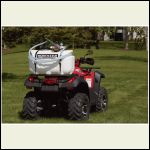
5.5 gpm , 26 gallon ATV sprayer for fire protection.
|  |  |
|
|
Just
Member
|
# Posted: 9 Feb 2013 04:34pm
Reply
If one looks in the upper left corner of this pic of our wood stove .You can see a 5 lb dry fire extingwisher rated for wood stoves thats all we have outside of a 5 gal pail and the river 50 ft. away and the surflow pump with 50 gal tank .. we have no 911 address so i hope we never need the firmen...
|
|
hattie
Member
|
# Posted: 9 Feb 2013 05:06pm
Reply
I've heard of building materials you can use that are fireproof. I found this article: http://www.icfmag.com/articles/features/fireproof_icfs.html
It looks pretty impressive.
Fire is always a big fear for us here. There is a volunteer fire department in the next town, but realistically, if there were a big fire I think we wouldn't have a hope. We have fire extinguishers and garden hoses and the man behind us has a well that he keeps just for firefighting in case.
I keep a list of what to grab in case of approaching fire. I figure we'd just throw it in the car and get out.
|
|
TomChum
Member
|
# Posted: 9 Feb 2013 05:40pm
Reply
In the spring when it's wet I will have burn piles. It seems to me like I should have some firefighting eqpt around. If there was a big forest fire I'd clear out! 26 gallons is nothing to a big fire.
|
|
MikeOnBike
Member
|
# Posted: 10 Feb 2013 01:24am
Reply
Metal roof, fiber cement siding, and a shovel. I'm putting in a 500 gal tank this spring and I have a lot of limbing up to do on the trees around our place.
|
|
wakeslayer
Member
|
# Posted: 10 Feb 2013 11:49am
Reply
It was so dry about 5 years ago in the area where our cabin is that ATV's, and chainsaw use were banned. If you were caught smoking a cigarette outside they would fine you. This lasted several weeks.
If there were ever a fire, I would soak the cabin with whatever was in my 1200 gallon tank, and GTFO. There is no way to protect ourselves.
I do have small extinguishers and a couple hundred feet of hose for a tiny event.
|
|
MtnDon
Member
|
# Posted: 10 Feb 2013 12:18pm
Reply
Fire protection comes in 3 parts for a cabin in a wildfire risk area.
1. Materials used to build and finish the exterior. Cement board siding is a no brainer, but along with that should be cement board soffits, fascia, trim. Metal roof is also a no brainer. Windows... special units using tempered glass and integral metal clips that hold the glass units in place if the veinyl melts. Special soffit vent material that when exposed to the heat of a fire expands and blocks the vent holes. For cabins on piers the underside should be fully skirted with something like metal panels. If there is an overhang or cantilevered floor the underside should be metal or cement board too.
2. Area around the cabin clear of grass and shrubs. Rake up leaves and conifer needles. Ideally all trees should be set back 30 feet from the exterior walls.
3. How much water to have on hand? In an ideal world I'd have a well and a 10,000 gallon cistern in ground so I don't have the freezing water thing to worry about. Pumps with backup pump(s).
My world is not ideal, so we have 300 gallons in one tank (stationary, by cabin), a hundred in a second tank (on trailer with pump), plus portable extinguishers. Portables include 4 of the water spray 2.5 gallon, 2 dry chem 40:B.C and several smaller 10BC and 20 BC in outbuildings.
IMO, the best most effective personal fire protection is preparation covered in #1 and #2 above. If "our fire" of 2011 had started west or SW of us instead of 2.7 miles to the NE there would have been nothing we could have done to stop it after it was burning.
|
|
TomChum
Member
|
# Posted: 10 Feb 2013 03:03pm - Edited by: TomChum
Reply
Quoting: MtnDon there would have been nothing we could have done to stop it after it was burning.
There is almost nothing ANYONE can do, with regards to equipment, to fight a forest fire. A forest fire takes a large, coordinated, and experienced team. (Not implying that you don't know that Don   ) )
But it seems something should be done to prepare for small fire safety. Was hoping this thread could focus on the equipment, if anyone has gathered any. For example what do you have if a kid flings a burning marshmallow overhead into some dry grass or needles. Or his dad is burning brush and the wind comes up? I was thinking that anytime I'm burning a brushpile I should have some level of fire protection there, and in the past, I only have a shovel and a 2.5 gallons of water (and the wet ground of a recent rain). But wind and a fire can dry the wet grass ahead of it.
I could never rake up the pine needles or cut all the trees near the cabin, I'd rather risk its loss, than to try to enjoy it all sterile. I actually IMPORT needles to keep the dust down. A neighbor who rakes his up into a pile brings them to me, because he doesn't enjoy the effort / risk in burning them. I have been thinning the trees nearby, but not thinned to the accepted "fire-safe" levels.
|
|
|
MtnDon
Member
|
# Posted: 10 Feb 2013 03:48pm - Edited by: MtnDon
Reply
Equipment: we have the aforementioned water extinguishers scattered about; gazebo, picnic area and playground area. Shed and barn have water and chemical. Cabin has chemical and I have one big CO2, plus one small in the Tacoma.
When we burn it is usually with snow on the ground. I don't like to burn much at other times unless the ground is soaked; then we usually do it at night. For that the trailer with the 100 gallons get parked close by.
And shovels and two tools whose names escape me at the present. They're used by FS crews for fire fighting.... like a big hoe blade on one side and a very coarse tooth rake on the other.
Comments on conifer needles and "duff"...
I used to think the pine needles made good mulch, something to slow down the rain water and give it more chance to soak in. Similarly I used to think the several inches of "duff" that collects on the surface; decayed matter, partially decayed matter, was also good mulch. Then I saw the fire the neighbor started by accident take off in a wind. Oh boy! When the fire fighters, all 6 engines, got there they told me later, that when they saw the raked ground around our cabin, they were certain they could save it.
The approaching fire stopped more or less on its own at the boundary from unraked and debris covered ground to out cleaned up and raked ground. In the area near that fire break about 15 trees, 60 to 70 feet tall pines, had their tops scorched enough that they never recovered. All died, though it took a year to be sure of some of them.
The fire fighters told us the next day when a crew came back for mop up that they were very worried as they came up the hill. The ground all around to that point was cluttered and layered with needles and duff. They told us that it was their opinion that we saved our cabin by cleaning and raking the ground around it.
So take that "evidence" and do with it what you want.
We still have trees too close, but not as many as 3 years ago. This year I have plans to remove a few more to increase distances between tops.
|
|
MtnDon
Member
|
# Posted: 10 Feb 2013 03:52pm - Edited by: MtnDon
Reply
McLeod !!
http://cspoutdoors.com/mcleodfiretool.html

|
|
MtnDon
Member
|
# Posted: 10 Feb 2013 04:00pm
Reply
Spring 2010
|
|
Dekagoldwingers
Member
|
# Posted: 10 Feb 2013 08:14pm - Edited by: Dekagoldwingers
Reply
Speaking as a retired Fire guy, I have a 2 1/2 gal pressurized water can which is nearby the fire when we burn, clearing or campfire. All fires start small and that's what extinguishers are for. Water Extinguishers can be improved in their extinguishing ability by adding "foam" additives to help the water cling to the material and stop the spread of fire. Even he addition of dishwashing liquid helps. Clearing away the "duff" is he best way to protect your property. Metal roofs are great. Cement board also works but it is pricey. To rotect your property in time of fire nearby, the best solution is fire sprinklers supplied by 3/4" hose placed to keep walls, and roofing wet. Also keep The underbrush wet to keep fire from approaching your buildings. It's good to remove trees around your property, but they contribute to keeping cool and reduce drying of the duff. Whenever burning, you should use a fir pit, where Burnable soil and Roots are removed down to mineral soil. Line the pit with rocks and if the area is dry soak the soil surrounding with buckets of water. Do not burn less than 12 hours before departure or if any burn bans are in effect. Check the area soil around the fire with bare hands to make sure it's cold. This cHaving a good underground water storage will be a great help In time of fire. Having some sort of pumping gear available in working order is essential. This is called cold tracing. Chain saws and axes and shovels are invaluable firefighting tools to reduce fire load in front of approaching fire. Pump cans are an efficient way to extinguish small fires and are easy to reload. For fuel you just need a stack of sandwiches!!
|
|
TheWildMan
Member
|
# Posted: 11 Feb 2013 09:01am
Reply
we get so much rain the woods here are nicknamed the abspestos forest. inside i keep a 55 gallon drum full of water by the woodstove and a 1 gallon pail by it (main water supply and good for fires if needed). i also keep an ABC (multi type) fire extinguisher in the cabin and one in each outbuilding. I also have a 3 gallon herbicide sprayer with water in it. each building has a rain gutter and 1 or 2 barrels for maximum water collecting and each barrel has a 5 gallon pail with it (rain harvest not used in winter). each building has a smoke alarm and Carbon monoxide detector on rechargable AA batteries.
can't get fire insurance, according to code office and every insurance company i went to my place isn't a real building (no regulated utilities, too small, no foundatuion etc) and i can't get insurance, fire prevention becomes a source of paranoia and i put a lot of effort into it (my own insurance is that my lot has two cabins, the old little one i spent a year iin and my new one, if one burned i still got heat and solar in the other on an indeendant system, my insurance is to have back up houses)
|
|
Dina95
Member
|
# Posted: 11 Feb 2013 09:18am
Reply
well.. this is a kind of a long term fire "protection".. and is not equipment... hope it helps! :D
http://www.youtube.com/watch?v=yxFEJN2B_6s
Also i think a big pond that seperates the dry land or dead trees will be an extra protection.. right?
|
|
littlesalmon4
Member
|
# Posted: 11 Feb 2013 12:51pm - Edited by: littlesalmon4
Reply
Fair to say we have given it some consideration. This fire was in July of 2009. This was a 37000 acre fire. Since this fire we have purchased a 37000 l/hr or about 9700 ga/hr pump. We have the 350' of fire hose with a nossle. We can also connect the pump to 2 5/8" hoses that are connected to 2 large sprinklers that mount on the front and rear peak of the cabin. They provide about 100' diameter coverage around the cabin. We are lucky that we are only 100' from the lake so water is not an issue
2009_235.jpg
| 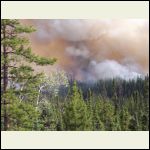
2009_237.jpg
| 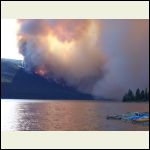
2009_269.jpg
| 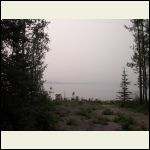
2009_257.jpg
|
|
|
TomChum
Member
|
# Posted: 11 Feb 2013 01:04pm
Reply
Lake is good. You can fight the fire to the end and retreat to the lake if necessary. 9700 gal/hr = 160 gal/minute = 2.6gal/sec. littlesalmon4 I think you can put up a good fight!
|
|
TomChum
Member
|
# Posted: 11 Feb 2013 09:27pm - Edited by: TomChum
Reply
Here are some other fire protection items.
The backpack pump (5 gallons) is $178, 55% the cost of the 26 gallon ATV sprayer ($319). I assume it's priced to gouge firefighting budgets. I've used this style, they work well. I wonder if a weed sprayer might be more efficient use of funds.
The kid pump at $11 is not such a bad deal (if they don't just fall apart). At such low cost it might be useful to have several around. If the kids happen to like them they can learn about fire safety.
5 gal. Backpack fire pump $178. Plastic for $159.
| 
Kid size for $11.42. They say it sprays 35 feet.
|  |  |
|
|
bldginsp
|
# Posted: 11 Feb 2013 10:26pm
Reply
No one has mentioned this yet, so here goes:
When you build a house in rural northern California woods they require a 2500 gallon water tank installed on the property. But, they don't require that you keep it filled with water, which is to say, they don't come around checking to see that everyone keeps their tanks full. So, the fire guys tell me, sometimes people don't keep them full of water and use them to dump their old motor oil and radiator coolant so they don't have to pay the fees at the recycle.
For fire safety I have thinned trees and burned some duff, and installed a 2500 gallon tank. I built a 200 sq ft. shed around the tank and I collect rain water off the roof of that shed to keep the tank full. I've had no problem filling it over the last 3 winters. The local fire chief scoffs when I tell him I fill with rain water, because he says it's unreliable, which is true. When I finish my cabin with shower and flush toilet, I will use 1/2 that tank during the dry summers here before it starts to fill again in the fall. So, I plan to get a second 3000 gallon tank, leave the 2500 gallon full, fill the other on a yearly basis and use it.
Having a 2500 gallon water tank delivered costs about $2000 or more. Instead, I bought mine at the manufacturer and drove it up on a little trailer. Cost me $750 to buy the poly tank from the manufacturer, I picked it up at the yard outside the factory and got to see how they make them on a huge rotisserie.
I have a sign on my property directing fire personnel to my tank, with blue reflectors on it (which means hydrant to fire guys) and the words 'FDC upper shed' on the sign. FDC means Fire Dept. Connection and tells them there is a hydrant.
Around here people sometimes actually steal water. No way to prevent that while at the same time leaving the hydrant available to fire crews at all times. At the shed the hydrant is covered with a little box that has blue reflectors and the letters 'FDC'. The box is removeable to access the hydrant. The box gives a contained space to put insulation into if/when the hydrant is charged during winter. Now, since I don't yet have a cabin, I shut off the main tank valve and empty the entire water piping system in fall for the winter.
Freezing water inside a tank is not a huge issue here, still I covered the outside of the tank with R13 fiberglass. It didn't freeze during the very hard freeze in Dec.
|
|
MtnDon
Member
|
# Posted: 11 Feb 2013 10:33pm
Reply
I have friends near Mariposa. They have storage tanks with a total capacity of around 15,000 gallons IIRC; all rain water. It gets split between domestic use, garden irrigation and for emergency fire use. Even at the end of the dry season they usually have 1500 gallons available.
|
|
bldginsp
|
# Posted: 11 Feb 2013 10:43pm
Reply
It's the irrigation that really uses it. By the time you buy 15-20,000 gallons worth of tank capacity, at about $.50 a gallon, you are a long way toward drilling a well.
|
|
dekagoldwinger
|
# Posted: 11 Feb 2013 10:47pm
Reply
Re: Fire Extinguishers. Check out your local Fire Extinguisher testing company. They often have refurbished units available at greatly reduced prices, that they have purchased from large industries etc. Also look into Water Pump Cans, not the backpack model, but the stand in the corner model. There are some available in plastic which are quite reasonably priced. Buckets still work well!
|
|
TomChum
Member
|
# Posted: 12 Feb 2013 11:02am - Edited by: TomChum
Reply
Quoting: dekagoldwinger Also look into Water Pump Cans, not the backpack model, but the stand in the corner model.
Searching the internet, "Pump cans" are amazingly "un-available". And On Google images use this: "pump can fire extinguisher". I like it though - classical and simple. Do you think there's a reason they no longer 'exist'? (i.e. do people throw them away after their house burns down??)
It's like some kind of internet vacuum - I couldn't find any plastic ones or inexpensive ones. I have used the "indian chief" metal cans they worked great for "casual" firefighting, or just wetting down where you don't want fire to spread. They don't require "compressed air at the re-fill station" which can be "a creek".
Any decent backpack fire extinguisher costs $160+. www.cssupply.com has the Genfo45.
This is an old pumpcan:  
I have one of these on my 'rebuild projects list'
| 
A waterbag style sprayer, Genfo45 $160+ www.cssupply.com
| 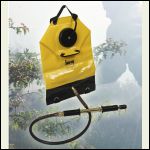
Guarany backpack sprayer (price unknown)
|  |
|
|
George
Member
|
# Posted: 16 Feb 2013 09:56am
Reply
Good thread.I live in a real fire prone area of Wa State.I have limbed up the trees 14',cleared 10 acres of any fuel,brush ect.Still no sure way to be 100% fire wise.Have a 550 gallon cistern, and looking into a high pressure foam sprayer to coat the cabin in case of fire.Actually a gell sprayer.
|
|
|

